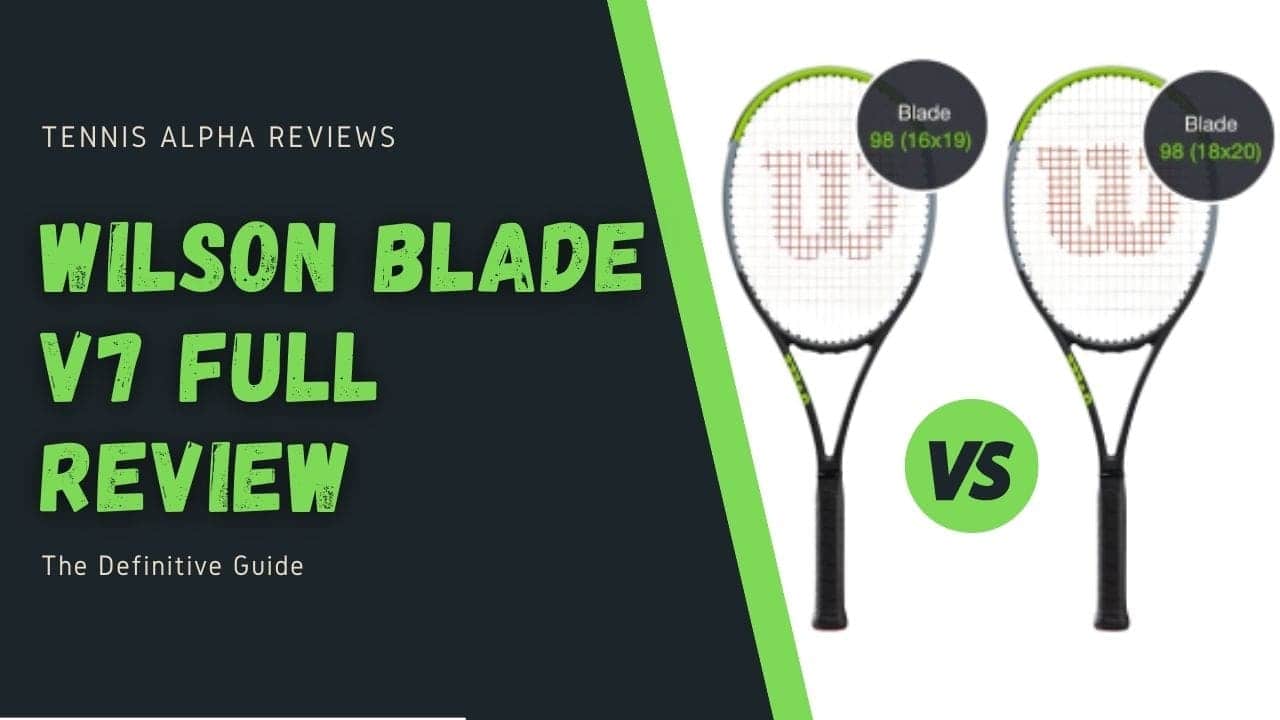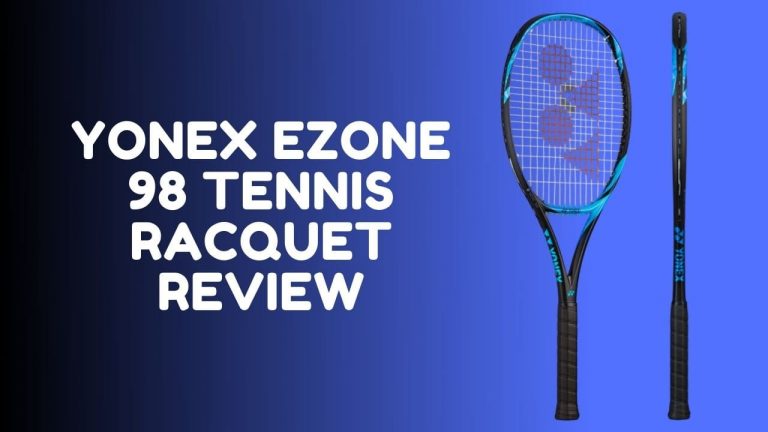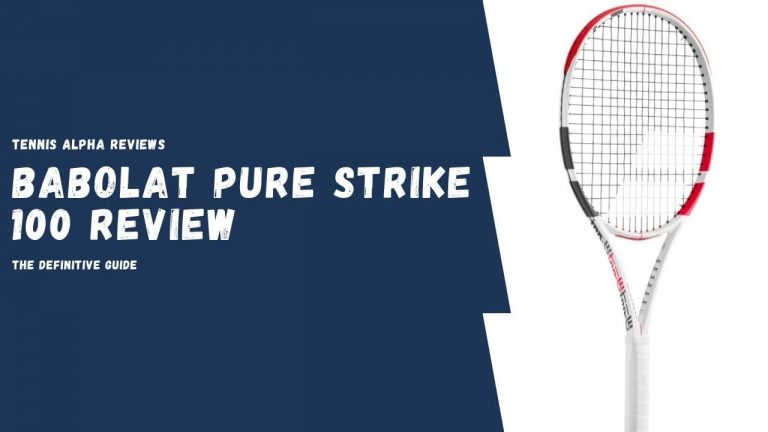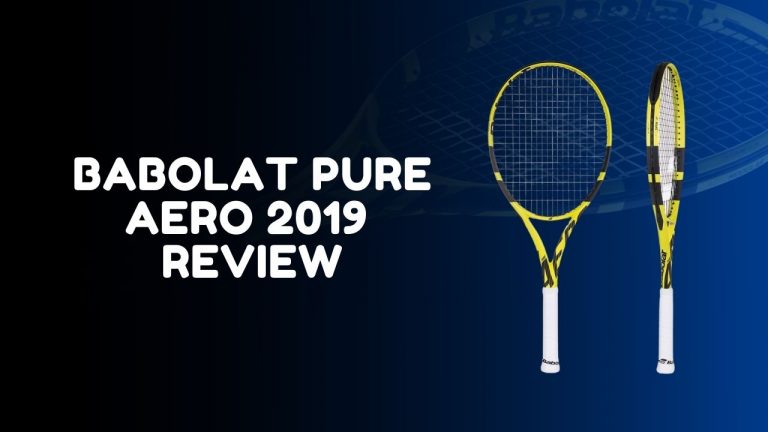
Today I’ll be reviewing and comparing the Wilson Blade v7 for both, the 16×19 and the 18×20 patents. My former main racquet used to be the full black limited edition Wilson blade v7 16×19 in the countervail version. Before I switch to the Gravity pro, as well as playing with a little bit of the BLX in the 2015 versions, I feel like I should have a decent idea of what the Wilson blade v7 is about.
Wilson blade v7 Quick Review
If you are in a hurry and you don’t wanna read the full review, we made it easy for you, just read this quick review to check out the characteristics of this amazing racquet.
For The Wilson Blade v7 16×19 :
| Head Size | 98 in² / 632.26 cm² |
| Length | 27in / 68,58 cm |
| Strung Weight | 11.4oz / 323g |
| Unstrung Weight | 305g/10,8oz |
| Balance | 13in / 33.02cm / 4 pts HL |
| Swingweight | 328 |
| String Pattern | 16 Mains / 19 Crosses |
| Power | 8.4 |
| Serves | 8.4 |
| Control | 8.3 |
| Groundstrockes | 8.5 |
| Maneuverability | 8.3 |
| Returns | 8.0 |
| Stability | 8.2 |
| Slice | 8.0 |
| Comfort | 9.2 |
| Topspin | 8.4 |
| Touch/Feel | 8.7 |
| Volleys | 8.8 |
| Forgiveness | 8.8 |
| Pros | Cons |
|
✅Powerful shots. ✅Great Confort. ✅Create more spin and power. ✅Good vibration dampening. |
⛔ Nothing we could agree on. |
For The Wilson Blade v7 18×20 :
| Head Size | 98 in² / 632.26 cm² |
| Length | 27in / 68,58 cm |
| Strung Weight | 11.4oz / 323g |
| Unstrung Weight | 305g/10,8oz |
| Balance | 13in / 33.02cm / 4 pts HL |
| Swingweight | 334 |
| String Pattern | 18 Mains / 20 Crosses |
| Power | 8.0 |
| Serves | 8.9 |
| Control | 9.0 |
| Groundstrockes | 8.9 |
| Maneuverability | 7.8 |
| Returns | 8.3 |
| Stability | 8.8 |
| Slice | 8.0 |
| Comfort | 9.2 |
| Topspin | 8.0 |
| Touch/Feel | 8.6 |
| Volleys | 8.8 |
| Forgiveness | 8.8 |
| Pros | Cons |
|
✅ Powerful shots. ✅Great Confort. ✅more stability and control. ✅Good vibration dampening. |
⛔Swing weight is a little heavy. |
Who is Wilson blade v7 Tennis racquet for?
The Wilson blade v7 is what I consider a perfect transition racquet for beginners who are looking to be introduced to a more advanced frame where it’s not quite exactly a tweener racquet, it also is not the most difficult to use if you’re capable.
It’s an extremely popular racquet. But one question that gets a lot of people stuck is which string pattern they should buy. Well, hopefully, this article answers that question for you.
Wilson blade v7 specs
Obviously, they differ in string patterns. Both have 305 grams unstrung on average with a 323-gram strong weight.
They have a 98 square inch head size with a constant beamwidth of 21 millimeters, which is considered a fairly thinner profile these days.
Both have a balance of four points headlight or 33 centimeters, and a stiffness rating of 62 RA Which in comparison to the countervail was 66.
But the biggest difference between the two is the swing weight with a 16×19 averaging 328 and the 18×20 averaging 334, where the countervail versions did not differ.
Wilson blade v7 Racquet full review
Feel and stiffness
Bot racquets have a much nicer and more noticeable flex in the countervail versions.
They’re both really nice to hit with, but people would consider more towards the muted side. If you’re really bothered by the muted sensations two ways you can improve it.
One is by using a really crisp string, something with a very sharp profile, like a Tour Bite or Volkl cyclone. I don’t think they would give you any discomfort in a racquet like this unless you may be strong above 55 pounds.
Also, if you’re used to having a dampener on your racquet, try removing. It doesn’t ping like most racquets since it’s already made it, to begin with, and the dampener might be an overkill.
There’s also no jarring on off-center shots and it really boils down to preference. It’s not as muted as the Countervail, but in comparison to most of the latest models out today, I would consider these racquets to be more on the muted side.
But I’d say it’s still a bit better than the pure stripe. So for feel and stiffness and give it a tie between the two racquets.
Power
Moving on to power, the Wilson v7 blades are not really powerful by any means.
They are on the lower side, but I wouldn’t consider them underpowered, as you really have some extremely control orientated racquets out there, such as the Prince 93P, the Prestige MP, and the ultra tour v3. My experience, on my higher pace rally balls.
The best feeling I could get was of the Wilson blade v7 16×19 as I had a much better pop. However, by the time I was received by the opponent seemed to lose some of that momentum.
So if compared to other similar racquets in this category, the extreme tour, and the gravity tour, they have a bit more of an edge in terms of power to the Wilson blade v7 18×20 provided a similar ball in terms of speed, but the trajectory was coming lower and would more often land in the opponent’s hitting zone, which makes it easier for them to hit, for a flat out winner type of shot.
The Wilson blade v7 18×20 came in handier because you were able to flatten out the ball easier and because of the swing weight, it had a lot more ability to plow through the ball, resulting in better penetrating shots for free power, I would give the edge to the Wilson blade v7 16×19, but if you’re a player that can self generate heavy paced balls the Wilson blade v7 18×20 will probably work better for you in the long run.
Spin potential
Speaking of trajectory, that brings us to the spin potential and launch angle. The Wilson blade v7 16×19 had a much higher launch angle in my subconscious targets and normally aimed towards the deep baseline or three-quarters court. So if you see my errors, they probably are longer than they are in the net, especially on the forehand wing.
This means that the Wilson blade v7 16×19 would require me to readjust my targeting, whether I would have to get accustomed to it for a couple of weeks or consciously target shorter parts of the court to compensate.
The spin itself was pretty decent, gave you the safety that you’re looking for, but none of them would necessarily be used as a big advantage. And for me, the spin wasn’t bringing the ball back enough down sometimes, so I’d overshoot a little bit. If you’re a flat hitter, then you’re going to want that free margin.
The margin is not necessarily something I have trouble with. If you want it to shoot off the court, you really have to take a harder swipe underneath the ball as it’s combined with a low power level. And unless you want to put that in yourself, you won’t create those drastic level changes visually for your opponent like you would with the pure strike.
Slices were pretty good in both racquets. They provided an easy amount of depth in the Wilson blade v7 16×19 cut enough into the court if you really wanted to.
The Wilson blade v7 18×20 would obviously have the edge there as the ball would just stay that extra bit lower 18×20 had a launch angle that was much more natural for my game since many of the frames I use tend to be tighter these days, it’s also easier to keep above the net than some other eighteen 20s, such as the PT 2.0, TF40 ultra pro and to some degree The Gravity Pro has for spin paired with the very spin-friendly string.
I think you get a good enough amount for an eighteen to twenty pattern. If you swing fast for your groundstrokes, you’ll be rewarded with a medium spin pace at a high level of consistency.
So again, for free spin, go with the Wilson blade v7 16×19 if you want that extra safety margin. If you’re a flat hitter, the 16×19 is a more versatile frame in terms of skill groups. But the 18×20 could be arguably directed towards more advanced players.
Control
Basically, if you feel like you have a low to medium level ability to generate pace then you’ll want to go with the Wilson blade v7 16×19 pattern basically because you’re going to want that extra free power and spin, and combined with your own ability, it would give you a good balance between the two where you won’t feel like it’s too heavy, underpowered or lacks depth and you’ll be able to likely hit out and keep the balls in just one
for my type of playstyle, which is more of an aggressive bass liner If I play any competitions with a tournament, I’m looking to swing extremely hard and produce some very penetrating shots.
The Wilson blade v7 18×20 gives me the confidence to swing out completely and decrease the risk of overheating. And my normal hits and rally balls, I found my consistency when using the 18×20 to be much improved, where some of my general rallies that I would play out hit maybe on average an extra three to four-shot before making a mistake,
For me, using the Wilson blade v7 16×19 combined with its launch angle was giving me too much height and I was even playing more than I usually would.
Just keep in mind, that is not to say that I can’t adjust to that over time. And the control isn’t actually bad with the 16×19. But for how I currently play at the moment, the Wilson blade v7 18×20 has much better control in my opinion. But that’s something you would typically expect anyway.
Serving
The Wilson blade v7 16×19 is a decent serving racquet. I would consider some extra weight at 12 or 3 and 9 o’clock to improve its plow through.
The countervail version was pretty unreliable and serves until you added the extra weight and once you did, it became a very good serving racquet.
Kick serves obviously will be with a 16×19 shines more a free kicker and plenty of height above the net is what you’re looking for and works very well with the Wilson blade v7 16×19.
The Wilson blade v7 18X20 is actually an extremely good saving racquet. I could really belt out some hard serves with pinpoint placement and it maintained its control and plenty of speed and penetration.
It provided a great slice of that really cuts into the ball and keeps a low before kick serves, You really need to hammer it and make sure your swing doesn’t hesitate.
Otherwise, you might find yourself dumping it or retreating without enough spin. Bringing it back down.
So for serves, I would give the edge to the 18X20.
Volleys
On the Volleys, I don’t think that either of them has felt too cumbersome. The 21-millimeter beam does allow you to cut through the air regardless of the swing weight on both
The Wilson blade v7 16×19 suffered just a little bit of instability. In general, the volleying wasn’t anything magical, but the improved feel of the racquet allows you to be more connected on touch and drop volleys compared to the previous model.
Again, adding a little weight to improve the twist weight is a good idea if that is an important part of your game.
The Wilson blade v7 18×20 is a generally much heftier swing weight and anything that is about 330 and above will provide you a good amount of stability to deflect and punch volleys.
Likewise, it benefits from the improved feel, just like the Wilson blade v7 16×19 insurgents are all around the 18×20 would be a much better volley racquet.
Stability and forgiveness
Well, stability and forgiveness from the baseline and the net. The Wilson blade v7 16×19 was just okay with stability. Personally, the one I was playing with seems to be an acceptable range.
If you’re new to what is considered to be a more advanced racquet, I think the Wilson blade v7 16×19 will do nothing but just this in terms of an upgrade to whatever you were using before.
Well, the levels that hover around high intermediate to advanced, you’re going to want to beef up that swing weight just a little bit to handle some of those opponents who can really hit out.
Obviously, the stability is a non-issue with the Wilson blade v7 18×20 coming in at a very high stakes swing weight and is highly unlikely. You need to add any weight to the group unless you get one that’s severely under the average spec range.
Forgiveness on both racquets was great. The sweet spot is more than enough for any player having off-center shots don’t feel harsh and doesn’t bring out any stiffer qualities and its flex.
It generally feels fantastic throughout the streambed on impact is much more desired in the 18×20, however, the six points of extra swing, it may be too much for some people to handle and the Wilson blade v7 16×19, and it can be fixed with just a little bit of extra weight.
The maneuverability
Finally, with the maneuverability, newer players introduced to a more head-heavy orientated racquet may struggle a little bit more with both racquets, but I think that the Wilson blade v7 16×19 is much more playable and stuff form with its ease of use.
For the Wilson blade v7 18×20, I highly recommend adding some tail weight as even for me I found a bit too much weight in the head.
But the difference between the Asian tour and this is that you have much more space to customize that extra weight into the handle. And once I brought up the aesthetic weight to around three 340 grams purely with extra add away to the handle, that’s when I could use it to its full capacity.
The Wilson blade v7 16×19 could also easily use some type of weight, but having either stock or customizing it did not have as much of a detriment to my game as the 18×20 didn’t stop for.
Wilson Blade v7 16×19 :
| Power | 8.4 |
| Serves | 8.4 |
| Control | 8.3 |
| Groundstrockes | 8.5 |
| Maneuverability | 8.3 |
| Returns | 8.0 |
| Stability | 8.2 |
| Slice | 8.0 |
| Comfort | 9.2 |
| Topspin | 8.4 |
| Touch/Feel | 8.7 |
| Volleys | 8.8 |
| Forgiveness | 8.8 |
| Pros | Cons |
|
✅Powerful shots. ✅Great Confort. ✅Create more spin and power. ✅Good vibration dampening. |
⛔ Nothing we could agree on. |
Wilson Blade v7 18×20 :
| Power | 8.0 |
| Serves | 8.9 |
| Control | 9.0 |
| Groundstrockes | 8.9 |
| Maneuverability | 7.8 |
| Returns | 8.3 |
| Stability | 8.8 |
| Slice | 8.0 |
| Comfort | 9.2 |
| Topspin | 8.0 |
| Touch/Feel | 8.6 |
| Volleys | 8.8 |
| Forgiveness | 8.8 |
| Pros | Cons |
|
✅ Powerful shots. ✅Great Confort. ✅More stability and control. ✅Good vibration dampening. |
⛔Swing weight is a little heavy. |
What To Choose Wilson blade v7 16×19 or 18×20?
the Blade Line is an all-around player frame directed towards a higher level of skill and a perfect way to get your feet wet into a whole realm of different racquets.
The Wilson blade v7 16×19 version is a great all-around frame for newcomers being introduced to more advanced racquets that still want a slight bit more free power and speed they’re accustomed to but a much heavier emphasis on control like they’ve never had before.
It also suits players that have a more traditional flat a game using Eastern grips and driving the ball but to be provided with the safety margins they may not receive from tight patterns and even more control frames.
If you are having quarrels with deciding what you need, you may be better off choosing this one as it provides mostly with what you need in stock form. And this versatile racquet is made for many skill levels with room to move in customization.
Wilson blade v7 18×20 is more suitable for people who know exactly what they’re looking for, with much more stability and control and not requiring any free power or spin, but just a completely solid racquet that will complement an advanced player in a wide range of categories and different play styles.
My personal recommendations for the 16×19 would be to bump up the swing weight a little bit with weight at 3:00 and 9:00 O’clock and count the weight in the handle to fix the balance that will ensure that you’ll be able to use it even as you improve your game, or if you’re already a high-level player, provide you with what you need for it Lacks.
Well, the 18×20, if the swing weight is too heavy, I would say if you can request one from the approach up to be a lower swing weight, say, around 330, you’ll have an excellent racquet without any additional worries.
If you counterbalance the head heaviness and maybe use extremely thin shot Palis in the 19 gauge or 1.15 millimeters, you’ll definitely have a real weapon in your hand.
Using thin sharp pulleys will allow you to also reduce the swing weight and provide you with the maneuverability that you’re looking for.
Summary
So guys Here is the complete Wilson Blade v7 review, which part of this article do you like most? Let me know in the comment section!
Now is your turn to pick one up and to take your game to the next level.
And don’t forget “Talk with your racquet, play with your heart”.






Perfect review. Thanks a lot. Can you tell me which swingweight the 18/20 v7 has unstrung? Thank you for your answer….